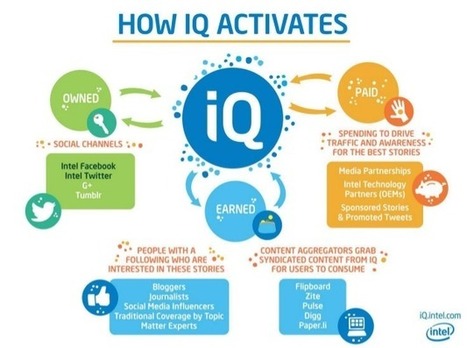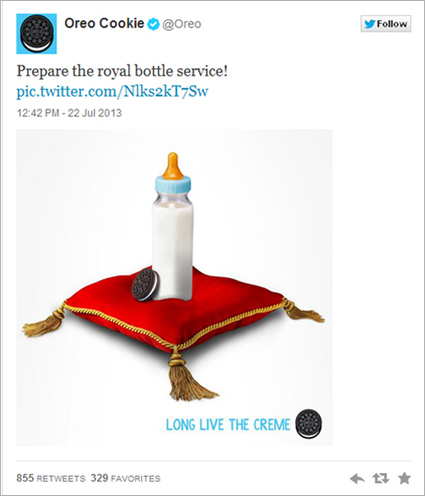 Your new post is loading...
 Your new post is loading...
“Storytelling.” It’s the flavor of the day, whether you’re talking about content marketing, visual communications or public relations, and for good reason. Stories are how humans communicate – with each other individually, across populations and over centuries.
In fact, many organizations are pretty good at identifying and defining their key story lines. The key to success in brand storytelling is in the next step – the strategic deployment of the story. Telling the brand story effectively requires a plan.
And to be clear, we’re not talking about hanging a touchy-feely post up on the blog and then calling it a day. No. Brand storytelling, in this context, means developing a sustained plan to create and execute a strategic approach to telling the brand story, in a way that supports company’s objectives. Personally, I don’t give a hoot about impressions. Let’s gun for something a bit more meaningful....
It says something about our media culture that in a short time the term “native advertising” has gone from industry buzzword to pop culture punch line.
The two most memorable references come from HBO. On “Girls,” Lena Dunham’s Hannah takes—and soon leaves—a writing job in the sponsored content department at GQ. More recently on "Last Week Tonight," John Oliver delivers an entertaining riff about the profusion of “sponsored content” on news sites.
Oliver conceded that Netflix's native ad for the New York Times about female prison inmates, promoting the series "Orange Is the New Black," was “about as good as it gets.” This got us thinking about all the other noteworthy executions this year which demonstrate that sponsored content can indeed be good—nay, great—content. With that in mind, we asked some of the native advertising gurus here at HuffPost-AOL to name their picks for the most notable native or branded content campaigns of the year thus far, both from around the Web as well as in-house.
Here’s what we came up with, in alphabetical order by advertiser....
A brand story is made up of all that you are and all that you do. From the company’s history, mission, inspiration, goals, audience, and raison d’être, it’s why you exist. Your story is the people, places, and ideas that your company thrives on. It’s the foundation that keeps a brand going and growing. It’s a blend of those vital little core pieces of information about your business — how you came to be, why your products or services are special, what you’re passionate about, your company culture, how you make people’s lives better, and why you would do business with your company.
Brand stories can be told in many different forms, with an evolving story line and cast of characters, but content creators must be vigilant about continuity and consistency, avoiding any holes. Your brand’s story has to resonate with people at a level that goes way beyond what’s tangible — the functionality, features, and benefits of your products or services — to create a deep, emotional connection with your audience. You have to create something that they want to be a part of and show that you really “get” who they are and what they need.
Here are a few basic questions to answer to help you pull your story out of its box
Drinking From the Content Marketing Fire Hose As we launched the site, the iQ team started to work with a team of journalists and editorial partners, conducted editorial meetings and worked closely with the Intel social media team to amplify and extend iQ content. Before we knew it, we were beginning to operate a newsroom, managing a robust content machine and starting to see our goals for iQ come to fruition. By end of 2012, iQ was emerging as an essential asset to Intel’s marketing and social media strategy. Although satisfied with the early success of iQ, we knew there were many improvements to be made. In January 2013, iQ version 1 (the current site) was released. Several new changes and strategies were implemented from our learnings since the BETA launch. So what have I learned about content marketing in the last 11 months? I’ve distilled the 12 core lessons for brand publishers organized by the tenets of the iQ content marketing approach; production, process and promotion....
Brand newsrooms are supposedly the next step in the ad agency’s evolutionary process. The rallying cry is for brands and their agencies to adopt a newsroom-style operation in response to modern media habits. But the reality is that your marketing team and ad agency are not in the business of creating news. This won’t work. Here are four reasons why. Brands are not in the content business. Neither are ad agencies, PR firms or digital shops. More importantly, they are not in the audience development business. That is what newsrooms are about — creating audiences that can be monetized. Everything about news organizations, from culture to employee compensation, is built around moving the audience needle. If you’re building a brand newsroom to enable real-time content production instead of enabling audience development across all your owned media properties, you’re looking through the wrong end of the telescope....
I was recently asked a provocative question: “What experiences or insights have shaped your views on brand and reputation management in today’s business environment?” This is a great question and the more I thought about it, the clearer the answer(s) became. 1. The first insight reflects the The Changing Role of Influence. There is a great quote by Gary Hamel, who says “Influence is like water. Always flowing somewhere.” This is very true in today's business environment as new sources of influence are forming around our companies and industries at an extremely rapid pace....
Journalism might not be dead, but it's hurting. An emerging option is brand journalism. Here's how to do that job the right way. That you’re reading this article for free, either online or from a mobile app, and probably found it through a “friend” you’ve never met, makes the following point: Journalism might not be dead, but it isn’t breathing normally. Robert McChesney, author of Will the Last Reporter Please Turn Out The Lights, argues the journalism industry is in a crisis. The decline in reporting jobs, coupled with the rise in public relations spending, is re-routing the paths of would-be journalists to careers in corporate communications, resulting in today’s out-of-whack 4-to-1 publicist-to-journalist ratio. But a third option is emerging: brand journalism. The social web has given rise to new expectations — transparency, accessibility and customer-centric content — that line-up nicely with skills learned in journalism school. As a result, “brand journalist” is becoming an increasingly popular job title. Companies like Twitter, Tumblr, Radian6, and Facebook, have all recently hired in-house reporters. If you are considering hiring — or becoming — a brand journalist, you need to distinguish the role from PR by adhering to seven basic, journalistic tenets of “traditional” media. Here’s what they are.... [Good read on brand journalism vs content marketing by Joe Chernov - JD]
|
...But while brand storytelling may be dominating the trade conference stages, it’s not enough on its own for brands aiming to add meaningful value to their customers over the long term.
Strategies for Retention: Own Every Consumer Touch Point
Most content marketers know this particular statistic: 70 percent of consumers prefer getting to know a company via content over ads. To deliver this type of lasting, comprehensive value to their audiences, brands must build their content strategy around three core areas of focus: Foundational content Engagement content Social content...
Many brands jumped into the real-time marketing fray with the Royals’ latest addition to the family on Monday. This effort wasn’t as effective as what took place during the Super Bowl blackout for a reason I’ll get into in a minute.
Still, I don’t think the Mashable headline, “Brands, Try, Fail to Capitalize on Royal Baby Hype” quite captures the situation. After all, the Oreo Cookie tweet triggered more than 800 retweets and more than 300 favorites, not exactly chopped liver (no charge Nabisco for the cookie filling idea).
...Brands are answering the call to create more value for customers by publishing news and content marketing. In fact, 86% of BtoC and 91% of BtoB organizations are now using content marketing tactics. As companies adopt a publisher model of content and media creation, many are beginning to rival the reach and influence of the publications in their industry.
Amex OPEN Forum and General Mills’ Tablespoon are great examples of this. What do these changes mean for Public Relations and Communications professionals? How is PR competitively positioned compared to marketing and advertising in a content centric web? Read on for answers to these questions and more.
By providing news content that traditional sources are not, brands are creating new connections with their communities and customers. While much of content marketing falls under the realm of corporate marketing, the expertise in messaging, content creation and media relations that many Public Relations professionals bring to the table can offer a competitive advantage in 3 key areas...
I'm always fascinated by organizations that embrace brand journalism, hiring reporters to create content that serves as marketing and public relations. For almost a decade, I've recommended that companies of all kinds model their sites not on their peers' boring old brochure-like approach but rather aspire to becoming like a media site such as Forbes, the BBC, or The New York Times and that they actually hire reporters and editors, not marketers and copywriters, to produce the content. One look at the Raytheon homepage shows they do exactly that. There are real-time news, images, and a top stories section. And Raytheon is a B2B (and B2G) company! "You can see our homepage is very much a news operation," says Corinne J Kovalsky, Director, Digital & Social Media at Raytheon. "We've got feature stories and trend stories about cool products."...
Content and commerce have always had a symbiotic relationship that many traditional content providers tried to separate. The wall between editorial and business, otherwise known as the separation of church and state, is and always has contained back doors and windows in which compromises are made. The slow adoption of all that the digital revolution has to offer – curation, aggregation, social, and automation – has also hobbled many traditional content providers. Depressed revenues, layoffs and shrinking bully pulpits are the results of an industry that doesn’t quite know how to monetize content beyond selling advertising space. Today’s successful digital companies know to blend content and commerce so that the content is compelling and, frankly, still sells stuff....
Many brands today are turning to storytelling in branding as a strategy to connect with consumers. These curated speeches demonstrate how this particular strategy benefits different brands and how it can be implemented in different industries.
I’m a simple soul. I deal in realities The first reality I see is that journalism as a career is under threat, because not enough people are prepared to pay for what we make
I can also see that any organisation is, or could be, a media company, in addition to whatever else it does. I see that many people are choosing to get their information through social media, rather than through the products of traditional publishers and broadcasters. Social media has changed the equation. We no longer live in a world where the rich and powerful control the means of mass communication. Now, anyone can publish their news, views, comment and analysis. Social media brings the added dimension to the dissemination of news and information that it is passed among groups of friends, colleagues or those bound by some other sort of self-defined common interest by way of personal recommendation.... [I like Andy Bull's approach to brand journalism. It's part of a series of Masterclass posts which are included in a Multimedia Journalism course online. The course is very reasonable and includes textbook and online resources for approx $55. Essential reading for marketing, PR and content marketing pros. - JD ]
|




 Your new post is loading...
Your new post is loading...






















nice
Storytelling is definitely the flavour of the day, not just for content marketers, but also for educators and learners alike! Stories are about making emotive connections, they are about being human and not cyborgs! Making connections is also about being able to "communicate with each other," as the article states, and it is about appreciating another's point of view!